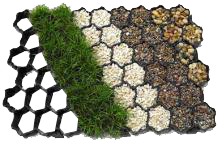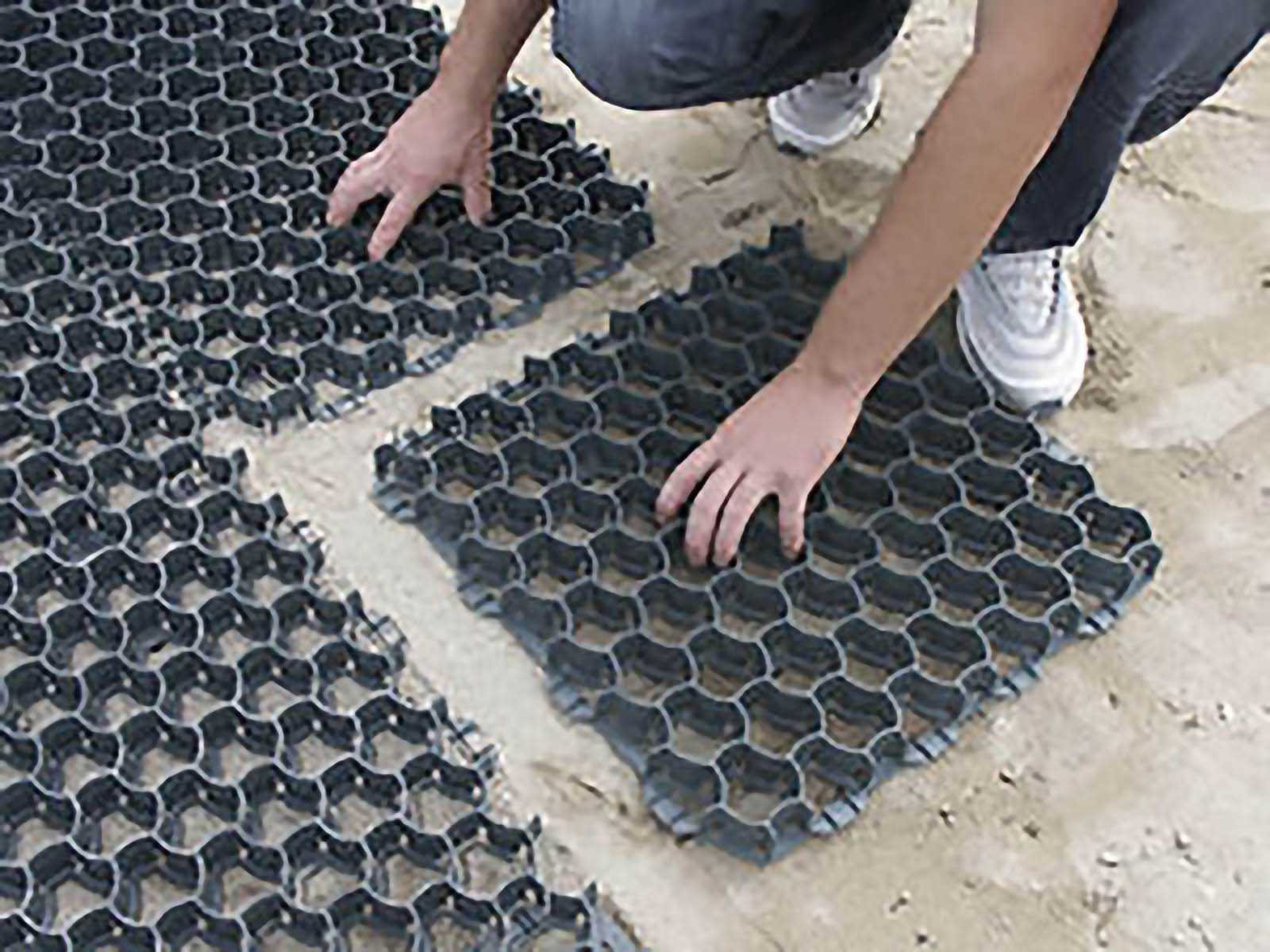|
|
|
What is GeoGrid?
Ok... In simple terms, GeoGrid
is a plastic
cellular paving grid for reinforcing grass, gravel or
decorative stones, creating a surface that is safe and
easy to walk, ride and drive on, while being free
draining. Surface water is returned to the ground rather
than putting pressure on drains and stormwater systems.
GeoGrid
offers an attractive alternative to concrete and asphalt
pavements and concrete grass stabilisation products, and
is very easy for the home handyman to install. The
plastic panels simply clip together and are laid just
under the surface. With the correct sub-base, GeoGrid
pavers can take the weight of trucks.
|
|
 |
|
|
GeoGrid with Soils or
Gravel

GeoGrid is geosynthetic
material used to reinforce soils and similar materials.
GeoGrid are commonly used to reinforce retaining walls,
as well as subbases or subsoils below roads or
structures. Soils pull apart under tension. Compared to
soil, GeoGrid are strong in tension. This fact allows
them to transfer forces to a larger area of soil than
would otherwise be the case.
GeoGrid with Grass
GeoGrid is perfect for reinforcing grass surfaced areas that
are prone to rutting and becoming muddy in wet weather.
GeoGrid acts as a perfect gravel retention
system, which not only allows for a free-draining
reinforced road or driveway for a surface which keeps
the angular stones within the its plastic cells which
ensures less gravel is displaced.
GeoGrid Installation

Ideally,
GeoGrid
paving
grids should be installed onto a firm, free draining and
well prepared relatively level sub-base.
The
grids are connected together and filled with either soil
for a grass surface (seeded or turfed), or filled with
an angular aggregate for a gravel surface.
We strongly suggest that all areas should have
sufficient drainage prior to the commencement of the
construction or the product may not perform as required.
|
|
|
|

In a Nutshell...
GeoGrid is a porous plastic cellular paving grid for
reinforcing grass or gravel where a permeable / porous
surface is required. GeoGrid grass pavers offer excellent ground
reinforcement due to the revolutionary interlocking
cellular grid structure and open cell structure which
allows either a grass or gravel surface.
GeoGrid paving grids are suitable for many traffic
applications, both pedestrian and vehicles, and include
car & coach parks, overspill car parks, emergency access
roads, grass walkways, golf buggy paths & grass or
gravel driveways.
The
reinforcement pavers allow rainwater or surface water to
penetrate the grid structure at source, allowing this
water to immediately infiltrate the ground, helping to
eliminate future flood risks whilst providing a firm
reinforced grass or gravel paving.
GeoGrid permeable pavers are manufactured from 100%
recycled polyethylene plastic in black as standard. We
can also manufacture the pavers in green or natural
colours subject to quantity. The paving grid material is
UV stabilised, strong, chemically inert & non-toxic.
GeoGrid porous grass pavers provide a durable,
environmentally friendly reinforced surface.
|
|
|
GeoGrid in real world
applications... |
One of our customers using GeoGrid for a
driveway...
|
|
 |
|
 |
GeoGrid
is significantly cheaper than concrete. On average GeoGrid is
75% cheaper! |
|
 |
GeoGrid
supports significantly more weight than concrete -
typically up to 200 tons per square metre! Where a
standard 100mm concrete surface can withstand only a
fraction of that. |
|
 |
GeoGrid lends
itself to being used with a variety of different infill
materials and aggregates such as Gravel, Road base,
Sand, Soil, Decorative Gravel, Pebbles and even Grass. |
|
 |
GeoGrid
is considerably lighter than concrete. One square
metre of concrete at 100mm thick weighs around
240kg! GeoGrid weighs just 4.5kg per square meter
and is half the thickness of a typical concrete
driveway, just 48mm. |
|
|
 |
|
Answers to your
Frequently Asked
Questions... |
|
|
What exactly is GeoGrid?
|
|
|
GeoGrid
is a cellular, interlocking, HDPE (High-density
polyethylene) plastic paving slab.
Ok.. In simple terms, GeoGrid
is a lightweight plastic slab, designed to stabilize and support grass or
decorative gravel.
GeoGrid
is used in the landscape, construction and environmental
remediation industries.
Positioned under the grass (or
gravel) surface, GeoGrid
distributes loads from pedestrian and vehicular traffic to
the subsoil below, minimizing grass and root compaction.
The
interconnected cells allow roots to develop with minimal
restriction, resulting in a durable and stable surface.
|
|
|
|
|
|
What is GeoGrid made from? |
|
|
GeoGrid is made from HDPE
(High-density polyethylene) plastic. |
|
|
|
|
|
What are the benefits of GeoGrid? |
|
|
GeoGrid
has many useful benefits, including...
|
 |
A soil stabilization ground
reinforcement eco-grid system |
 |
Visually unobtrusive: 95% of surface area available for infill |
 |
Do-it-yourself installation in
many applications. Can be saw cut
|
 |
Load bearing capacity
of up to 200 tons per square metre |
 |
Typically one third the price
of concrete |
 |
Environmentally friendly paving
alternative |
 |
Prevents soil
compaction - water permeable surface |
 |
UV stable, unaffected by extremes of temperature |
 |
GeoGrid
is 100% recyclable and non-toxic |
 |
Interlocking
system to prevent lateral movement |
 |
Easy to install, can
be cut to accommodate design details |
 |
Can be soil & seeded or gravel
filled as an alternate landscaping system |
 |
Allows storm water to flow
directly into natural aquifers |
 |
Wide temperature resistance...
-40?C to 90?C |
|
| |
|
|
|
|
What can GeoGrid be used for?
|
|
|
GeoGrid can be
used for a variety of ground stabilization applications,
including...
|
 |
Car parks |
 |
Dust
reduction |
 |
Landscaping |
 |
Grass car
parks / fairgrounds |
 |
Helicopter landing pads |
 |
Emergency
vehicle access roads |
 |
Fire
lanes |
 |
Golf cart
paths |
 |
Bus
parking |
 |
Farm
driveways |
 |
Overflow
parking |
 |
Storm
water management |
 |
Livestock
pathways |
 |
Caravan
parks |
 |
Temporary
staging areas |
 |
Plus lots
more... |
|
 |
Parks |
 |
Erosion
control |
 |
Heavy
equipment parking |
 |
Concrete
alternative |
 |
Green
space |
 |
Muddy
parking solution |
 |
Freight
yards |
 |
Grass
verges |
 |
Traffic
islands and roundabouts |
 |
Machinery
shed flooring |
 |
Footpaths |
 |
Disabled
/ wheelchair access |
 |
Driveways |
 |
School
playgrounds |
 |
Job &
construction sites |
|
|
|
|
|
|
|
|
|
What materials can I use with GeoGrid?
|
|
|
GeoGrid lends
itself to many infill materials and aggregates such as...
 |
Gravel |
 |
Road base |
 |
Sand |
 |
Soil |
 |
Decorative gravel |
 |
Pebbles |
 |
Grass |
|
|
|
|
|
|
Where do you ship GeoGrid to?
|
|
|
We ship
GeoGrid to Australia only (Eastern States).
Click here for shipping information
|
|
|
|
FREIGHT
NOTICE: Please note,
due to rising fuel and freight
costs, we ship GeoGrid within
Australia, Eastern States Only.
Specifications
are correct at time of
publication but are subject to
change and/or improvement
without prior notice. *Saving
when compared to the typical
price of concrete. |
|
|
|
|